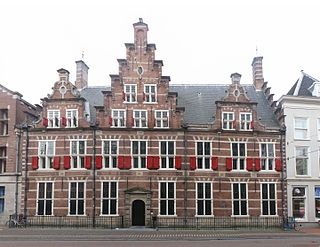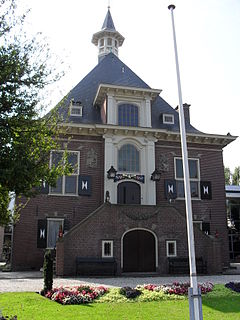
The Royal Palace of Amsterdam in Amsterdam is one of three palaces in the Netherlands which are at the disposal of the monarch by Act of Parliament. It is situated on the west side of Dam Square in the centre of Amsterdam, opposite the War Memorial and next to the Nieuwe Kerk.

Zwanenburg is a town in the Dutch province of North Holland. It is a part of the municipality of Haarlemmermeer, and lies about 11 km west of Amsterdam.
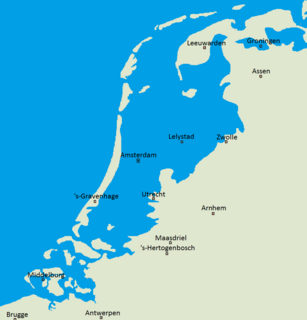
Flood control is an important issue for the Netherlands, as due to its low elevation, approximately two thirds of its area is vulnerable to flooding, while the country is densely populated. Natural sand dunes and constructed dikes, dams, and floodgates provide defense against storm surges from the sea. River dikes prevent flooding from water flowing into the country by the major rivers Rhine and Meuse, while a complicated system of drainage ditches, canals, and pumping stations keep the low-lying parts dry for habitation and agriculture. Water control boards are the independent local government bodies responsible for maintaining this system.

Pieter Jansz Post was a Dutch Golden Age architect, painter and printmaker.

Nicolaas Samuelszoon Kruik, also known as Klaas Kruik and Nicolaes Krukius, was a Dutch land surveyor, cartographer, astronomer and weatherman. He is remembered most today for the Museum De Cruquius bearing his name.
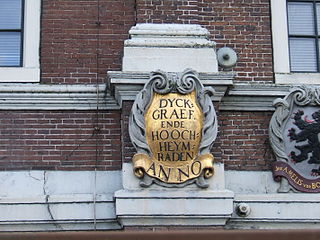
Dutch water boards are regional government bodies charged with managing water barriers, waterways, water levels, water quality and sewage treatment in their respective regions. These regional water authorities are among the oldest forms of local government in the Netherlands, some of them having been founded in the 13th century.
Drainage districts occur in England and Wales, varying in size from a few hundred acres to over 100,000 acres (400 km2), all in low-lying areas of the country where flood risk management and land drainage are sensitive issues. Most drainage districts are administered by an internal drainage board (IDB), which are single purpose local drainage authorities, dealing with the drainage and water level management of clean water only. Each drainage district has a defined area, and the IDB only has powers to deal with matters affecting that area.
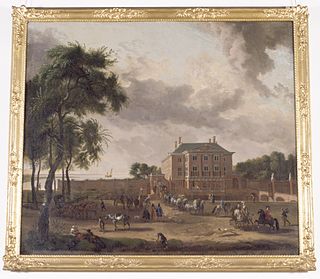
The Gemeenlandshuis Zwanenburg on the Haarlemmerstraatweg in Halfweg is a former Gemeenlandshuis of the Hoogheemraadschap van Rijnland designed by Pieter Post and built 1645-1648. Today it is part of Sugar City.

Christiaan Brunings was a Dutch hydraulic engineer.
The Hoogheemraadschap van Delfland is a Dutch waterboard, which is responsible for water management. It covers the municipalities of Delft, Midden-Delfland and The Hague, and is fully located in the province of South Holland. The organization was established in 1289 when William I, Duke of Bavaria authorized the "Heemraden of Delft" to manage water and serve as a court.

The Wijnkopersgildehuis is a former guildhall in Amsterdam. The 17th-century double house is located at Koestraat 10-12, near Nieuwmarkt square. It is one of the few remaining guildhalls in Amsterdam and has the oldest known neck-gables. The building has rijksmonument status.

The Officers of the St George Militia Company in 1639 refers to the last and largest schutterstuk painted by Frans Hals for the St. George civic guard of Haarlem, and today is considered one of the main attractions of the Frans Hals Museum there.

The Holy Spirit Orphanage was an orphanage in the city of Leiden in the Netherlands. It is a Rijksmonument located on Hooglandse Kerkgracht 17B.
The following is a timeline of the history of the municipality of Leiden, Netherlands.
Schielands Hoge Zeedijk, formerly called Hoogendijk is a Dutch dike in the province of Zuid-Holland that stretches from the Schie at Schiedam to the Gouwe near Gouda. Constructed in the 13th century, the dike continues to protect an area inhabited by 3 million people from flooding by the North Sea.



